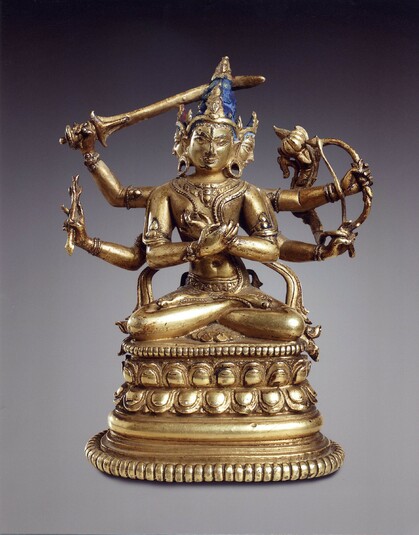
Item: Manjushri (Bodhisattva & Buddhist Deity) - Manjuvajra, Namasangiti (3 faces, 6 hands)
| Origin Location | India |
|---|---|
| Date Range | 1100 - 1199 |
| Lineages | Buddhist |
| Material | Metal |
| Collection | Rubin Museum of Art |
Manjushri, Manjuvajra (Tibetan: jam pal yang, jam pal dor je): one of many complex forms of the deity Manjushri having arisen from the text of the Manjushri-namasangiti Tantra [TBRC W22003]. There are seven main mandalas with deities and this is the seventh from that group.
"Holy Manjuvajra, orange, with three faces and six hands, the main face is orange, the right face blue, left red. The first two hands embrace the self-luminous consort and the two lower right [hands] hold a sword and arrow. The two lower left hold a bow and a blue utpala [flower]." (bod brgyud nang bstan lha tshogs chen mo bzhugs so, 2001. ISBN 7-5420-0816-1).
The Manjushri Namasangiti Tantra was first translated into Tibetan in the 8th century and re-translated during the Sarma period in the 11th century and classified as both a Yoga and Anuttarayoga Tantra. It depicts numerous forms of Manjushri both peaceful, wrathful and full mandalas with many deities such as the Dharmadhatu Vagishvara. Monks and lamas from all traditions memorize the Tantra in early childhood.
Lineage of Teachers: The Perfect Buddha, Holy Manjughosha, Khache Yeshe Dorje, Lobpon Jampal Dragpa, Kepa Palpe Zangpo, Dramze Yeshe Dorje, Sherab Jungne Bepa, Dramze Shepa Dorje, Padmakaravarmin, Shraddhakaravarmin, Lochen Rinchen Zangpo, Lochung Legpai Sherab, Ngog Ge Serwa, Kyangpo Dharma Drag, Triton Kunga Ozer, Khenpo Chokyi Dorje, Kunkhyen Choku Ozer, Pago Yontan Gyatso, Buton Rinchen Drub, Tugse Rinchen Namgyal, Jamyang Dragpa Gyaltsen (1365-1448), Sharchen Yeshe Gyaltsen (d.1406) [TBRC P3094], etc.
Jeff Watt 8-2005
Buddhist Deity: Manjushri Main Page
Collection of Rubin Museum of Art: Sculpture (Gallery 2)
Buddhist Deity: Manjushri, Namasangiti Main Page
Buddhist Deity: Manjushri, Manjuvajra Namasangiti (3 Faces, 6 Arms)
Buddhist Deity: Manjushri Sculpture Page
Collection of RMA: Best of Collection 1
Collection of RMA: Selected Sculpture
Region: India, Pala Period (Metal Sculpture)
Collection of RMA: Best of Collection (Sculpture)
Buddhist Deity: Manjushri, Namasangiti (Masterworks, Sculpture)
Buddhist Deity: Manjushri, Namasangiti (Sculpture)
Buddhist Deity: Manjushri (Sculpture Masterworks)
Collection of RMA: Manjushri Masterworks

